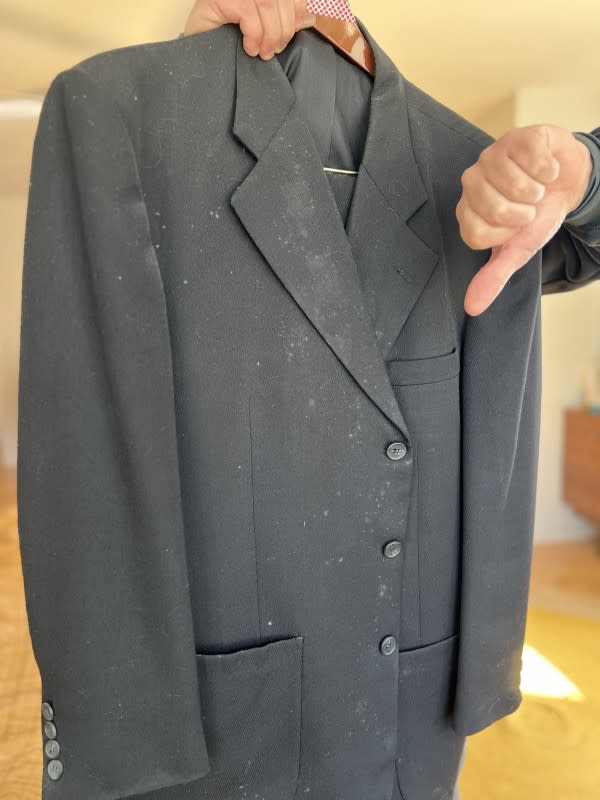How to Clean White Mildew Off Clothing
Men’s Journal aims to feature only the best products and services. If you buy something via one of our links, we may earn a commission.
Have you ever opened your closet to discover an unpleasant musty odor, or find your favorite clothing items covered in unsightly white mildew spots? While white mildew on fabric itself isn't typically harmful, its odors are unpleasant. Plus, it leads to discoloration and deterioration of fabric. People with mold allergies might even feel symptoms before they notice a mold smell or its presence in the clothing fibers. As soon as you notice white mold exposure, make sure you take steps to prevent its spread and growth. While you're at it, make sure you check all other garments that were in the same area; if moisture in a drawer, closet, or storage tote was an issue, it's likely that other items are also affected.
Mildew vs. Mold
Mildew and mold are both types of fungi, but they are notably different:
Mildew is a surface fungus that appears as white or gray powdery patches. It's easier to clean and generally less harmful than mold.
Mold is a more invasive fungus that can appear black, green, or blue and often has a fuzzy or slimy texture. It can penetrate surfaces and spread rapidly, causing structural damage and health issues such as respiratory problems. Mold often requires mold removal services and extra remediation efforts.

Emily Fazio
Cleaning Mildew of Clothing in a Few Simple Steps
Prepare the clothing. Before treating mildew stains on moldy clothes, brush off any loose mildew spores outdoors to prevent spreading them further.
Wash affected garments. Wash the item immediately in hot water (or, the hottest water that is safe for the type of fabric—check the care label). A hot water temperature offers extra cleaning power. Use a heavy-duty laundry detergent and add a cup of white vinegar to the wash cycle. The vinegar solution is effective in killing mildew and removing its stains. Cleaning delicate fabrics? Pay special attention to the recommended cleaning process. A spot-treatment using a store-bought cleaning solution may more effectively remove mildew from fabric.
Bleach in sunlight (or use an oxygen-based bleach cleaner). After a cycle in the washing machine, hang the item outside in direct sunlight to dry. Sunlight helps to kill lingering spores and fade any remaining visible mold stains. For stubborn mold stains, create a homemade solution using a gallon of water and oxygen-based bleach according to the product's instructions. Soak the clothing item with persistent stains in this solution for several hours or overnight before washing it again. Still not clean? Take the garment for professional cleaning services.
Address your storage area. Make sure your clothing storage is cool and dry. Running a dehumidifier during humid seasons can help reduce moisture in the air that settles into clothing. Encourage good ventilation, and always make sure that clothing items are completely dry before storing them away for the season. If you continue to see signs of mold, consider a professional mold inspection.
Related: How to Keep Your Linen Closet Smelling Fresh—Mom Approved
What causes mildew on clothes?
Moisture: Wet clothes that aren't properly dried before storage (or are stored in humid environments) can accelerate the growth of mold. Avoid putting wet laundry in the laundry basket!
Poor Ventilation: Lack of ventilation in storage areas can trap moisture. Air circulation keeps clothes dry and prevents mold growth.
Improper or Long-Term Storage: Moisture trapped in sealed containers provides an ideal environment for mold spores to thrive. Also, clothes that are stored for long periods without being worn or aired out are more susceptible to mildew growth
Contaminated Surfaces: If clothes come into contact with mildew-infested surfaces, such as walls, floors, or other fabrics, they may become contaminated as well.
Related: 5 Obvious (But Simple) Solutions That’ll Improve Your Bedroom Organization
Which store-bought products are the best for cleaning mildew?
For white fabrics: While chlorine bleach will also resolve stains and smells on moldy clothing, be mindful of using it in concentration. If necessary, dilute a cup of bleach in a bucket of water, and submerge the garment. Then, rinse with clean water and launder as usual. Remember: Never mix white vinegar and bleach together; it forms a toxic gas.
